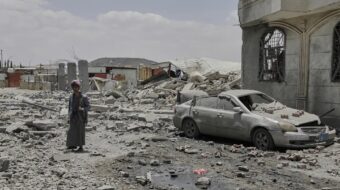
Congo: White King, Red Rubber, Black Death
Peter Bate, director
2004, Belgium/UK, ArtMattan Productions (U.S. distributor)
100 min., English/French/Dutch with English subtitles
An African proverb reminds us, “Until the lions have their historians, tales of the hunt shall always glorify the hunter.” I reflected on variations of this sentiment as I made my way home teary-eyed after seeing “Congo: White King, Red Rubber, Black Death” recently in New York.
British filmmaker Peter Bate’s stirring documentary brings to the silver screen the unspeakable horrors of Belgian colonialism in the Congo. The crimes committed by the Belgians were met with American and European acquiescence, well described by Mark Twain in his book “King Leopold’s Soliloquy” more than a century ago.
The film begins with scenes of terror — Congolese children, men and women without their hands. We learn that their hands were cut off by the colonizers or their puppet troops in a macabre system of accounting. Sometimes hands were cut off because workers didn’t work fast enough. Sometimes the puppet troops brought back hands as evidence they had killed workers who had failed to meet their rubber bounty. Other times such hands helped the puppet troops “prove” they hadn’t wasted any bullets on hunting game, an offense in the eyes of the colonialists.
Children’s hands were chopped off as punishment for late deliveries of rubber.
Later in the film an African chief employs another kind of accounting: a fact-finding commission views a huge bundle of sticks representing the chief’s many “missing” villagers. Such stories about the destruction of villages, rape and torture abound in the film.
Fittingly, the film takes us to Brussels for a look at the other side of the tragedy as we see the city’s magnificent infrastructure and its children salivating over chocolate hands reminiscent of those missing on the amputees.
The fanatical rush for colonies, rubber and other raw materials was part of the drive to industrialize Europe. These valuable resources helped usher in Europe’s motorized transportation and the proliferation of many other commodities. African raw materials were prime targets of these insatiable demands.
For example, during the Belgian reign of terror, John Dunlop created the pneumatic tire, setting off a surge in bicycle sales and creating a huge demand for rubber latex and wild Congolese vine rubber.
In order to properly manage and maximize exploitation of Africa and to ease conflict among themselves, European imperialist powers sat around tables in Berlin, Germany, between 1884 and 1885 and decided the partition and colonial fate of Africa. Like butchers with knives dripping blood, the imperialists divided the continent into spoils. No regard was given to traditional borders or other historical factors.
It was to Congo’s misfortune that King Leopold was given this, the largest and, soon to become evident, richest chunk of the richest continent.
The film presents in almost elementary fashion the machinery of colonialism. It sheds light on how Belgium used European soldiers, administrators, businesspersons, missionaries and journalists and African collaborators to set in motion a system that transformed the huge, resource-rich, heart of Africa into a zone of death and conflict. That legacy is still with us today, and the region remains among the poorest areas on earth.
Over the next 20 years of direct Belgian rule, 10 million Africans would die by murder, disease and the deplorable conditions of life. Resistance was put down by wanton murder and what today we would call “ethnic cleansing.” In the meantime, the Anglo-Belgian India Rubber and Exploration Company was racking up 700 percent profits on its shipments of rubber from the Congo. The company’s stock-market valuation increase 30 times in six years. King Leopold was celebrated in European capitals as a humane and progressive pioneer of Christian values in “darkest Africa.”
The film includes intermittent scenes from an imaginary trial of Leopold, placing the responsibility for “civilizing” the Congo on his shoulders. The bearded monster appears in full regalia all too often in the film for my tastes, but his trial for Hitler-like crimes, when it does take place, seems long overdue. Yet this writer feels that Leopold’s role is given too much emphasis, while a wider concert of sadistic players in a global system gets too little attention.
Today the colonial exploiters of the Congo are, under a different, neocolonial guise, still reaping profits from its land and people. A global diamond industry and the extraction of rare minerals and metals like colton for the burgeoning telecommunications, electronic gaming and other new technology industries, continues. In the meantime, the area known as Great Lakes Africa still bleeds.
Director Peter Bate and the film’s narrator, Congolese professor Elikia M’Bokolo (Ecole des Hautes Etudes en Sciences Sociales in Paris), follow the tradition of Mark Twain in proving to us that the “lions can have their historians.”









